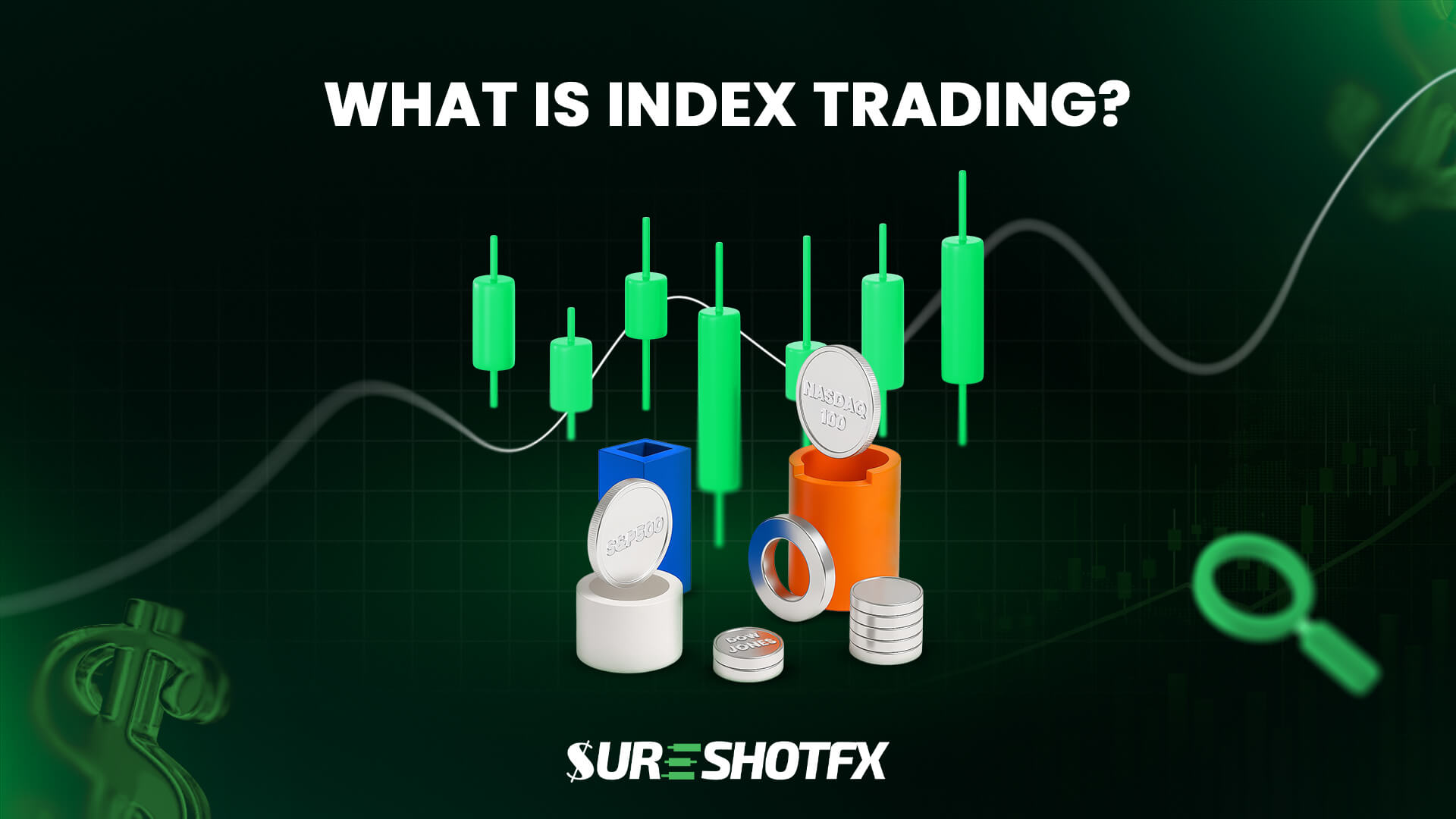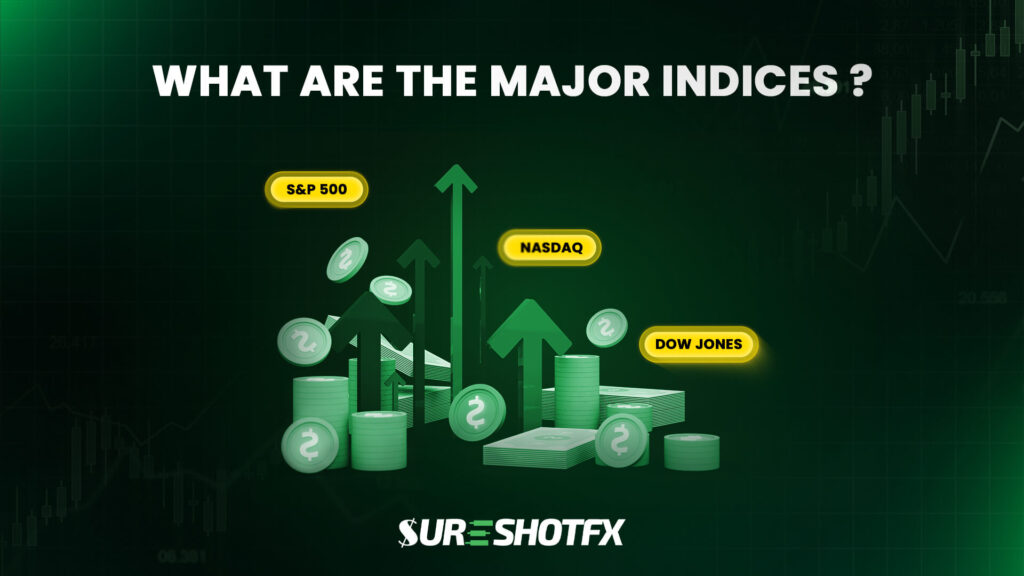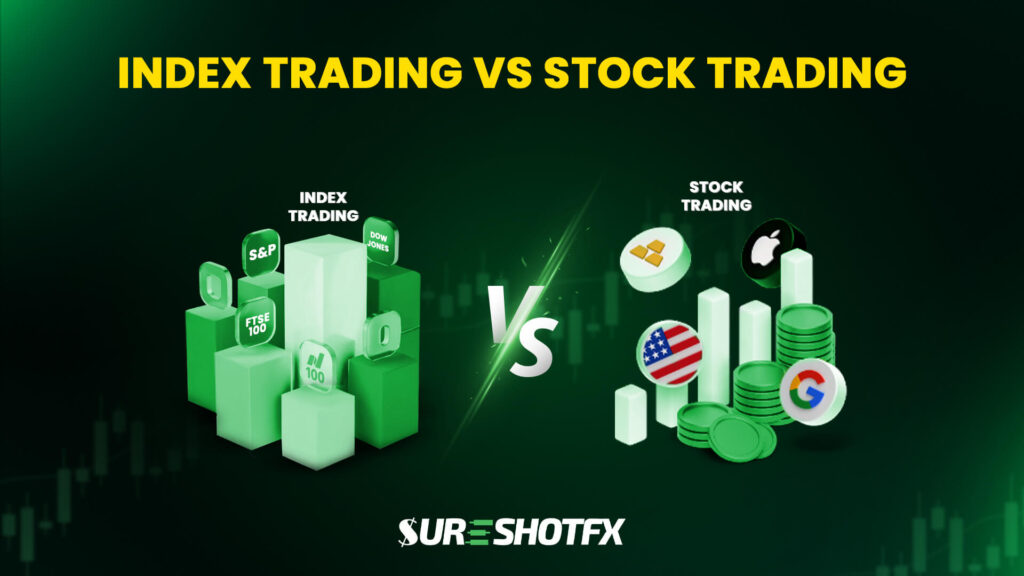What Is Index Trading? How to Trade the Best Stock Market Index in 2026

Ever heard of something like “Tech and AI earnings are empowering Nasdaq’s strong performance?” This shows a trend for an index market. Trading indexes lets you gain exposure to a large market and capitalize on overall market gains instead of an individual stock.
Confused about what is index trading? Don’t fret because, in this comprehensive guide, we have included everything about index trading and the major indexes for profitable trade in 2026. And all are explained in simple terms for you.
So, let’s dive deeper.
Key Summary
- Index trading is the buying and selling of an index in the stock market for a particular profit target.
- “Index” and “indices” are the same; “indices” is just the plural form for “index.”
- 3 Major indices popularly traded are- NASDAQ, DJIA, and S&P 500.
- Index trading can be profitable for beginners if traded with proper strategies and risk management.
- Avatrade and Oanda brokers suggest index trading using CFDs or ETFs.
What Is an Index?
An index is a statistical measurement representing the price performance of a group of assets. These assets can be a group of companies, stocks, and bonds.
In the stock market, an index basically shows how a group of companies or stocks is performing overall. S&P 500, NASDAQ 100, DJIA, etc. are popularly traded indexes, covering giant-cap (capital) companies. These are broad-based indexes because they track many companies across different industries.
Let’s consider the index S&P 500, which is an index of 500 large US companies. Now, if the S&P 500 index goes down, it means most of the companies under this index are going down or losing value.
Again, some indexes are more specialized, focusing on specific sectors or types of companies. For example, the Russell 2000 Index tracks only small-cap stocks (companies with smaller capital).
So, index meaning in trading and finance is different. You can think of an index as a scoreboard showing how the stock exchange market is performing at any given time.
What is an Index in Trading?
Index trading is the buying and selling of indexes, such as S&P 500, DOW Jones rather than trading individual stocks/assets. Here, you are trading on the overall market movement of a group of stocks or a specific sector, instead of picking individual stocks.
Trading by monitoring this combined performance stock is known as stock market index trading. NASDAQ-100, S&P 500, DJIA, Volatility 75, Sensex, FTSE 100, and Dow 30 are some index trading examples.
If you want to learn index trading in simple terms, then think of an index as an indicator for the stock market, which shows whether the stock market is going up, down, or staying stable. Traders trading indexes are called index traders or indices traders.
How Index Trading Works
Index trading works by trading based on the overall direction of any stock market, without trading for any individual companies.
Simply put, instead of buying a Tesla or Apple share, you trade for the market price movement of an entire market index, like S&P, NASDAQ, etc.
Basically, these indexes track the performance in the market for these multiple companies in a single trade. That’s why index trading in the stock market refers to the trading of a basket of stocks, representing an individual stock index.
CFDs (Contracts for Difference) and ETFs (Electronically Traded Funds) are two popular financial derivatives used in Index trading by many brokers. It’s because these allow you to trade on price changes without actually owning the underlying asset.
Besides, traders can trade CFDs or future option trading as a foremost indicator of market volatility based on the stock index value for a certain period of time.
What are Indices in Trading?
Indices is the plural form of index. The difference between “indices” vs “indexes” is nothing major. Indices mean the same as ‘index,’ but the term ‘index’ is more casual in the US stock exchange market.
Origin of Indices at a Glance
ProQuest shows that, in the 18th century, the world’s first index was created by a financial journalist, Charles Dow. And it was none other than the popular DJIA (Dow Jones Industrial Average).
It was then published in The Wall Street Journal and consisted of 12 big companies covering major economic sectors at that time. And over time, DJIA evolved to include 30 significant US companies.
Following the DJIA, other indices emerged, such as the Nikkei 225 in 1950, the S&P 500 in 1957, the FTSE 100 in 1984, the NASDAQ 100 in 1971, and so on.
What Are the Major Indices You Can Trade in 2026?

Some well-known major indices include the S&P 500, Nasdaq 100, Dow Jones, FTSE 100, Nikkei 225, Sensex 50, etc. In the USA market, the S&P 500, Dow Jones, and Nasdaq are the 3 major indices to trade in 2026. And in the international market, the FTSE 100 (Financial Times Stock Exchange) and the Nikkei 225 are the best and most profitable trade indexes.
However, Dow Jones and S&P 500 are also the best indices to trade for beginners. So, let’s learn more about them.
S&P 500/Index SP:
The S&P 500 Index (SPX) is one of the most followed indices, tracking 500 (now 503) US companies. Traders trading the S&P index trade the overall price movement of these 500 companies.
The Standard and Poor’s 500, or in short, the Index SP, is a public float including around 80% of the total market cap (capitalization).
The top 10 companies from the S&P 500 index make up around 38% of the total index value, and the top 50 companies make up 60% on average.
Among the 10 biggest companies, Microsoft and Nvidia are the most promising, each holding a 7.0% share of the index. And then
→ Apple with 5.8% share
→ Amazon with 3.9%
→ Alphabet (Google) with 3.6%
→ Meta Platforms with 3.0%
→ Broadcom with 2.3%
→ Berkshire Hathaway & Tesla, each with 1.8%
→ JPMorgan Chase with 1.5% share
DJIA (Dow Jones Industrial Average)/Dow Jones:
DJIA, simply the Dow, is another major stock market index, including 30 prominent and publicly traded US companies. This equity index is also known as the US 30. It includes fewer stocks but higher risk.
Blue-chip companies like Apple, Coca-Cola, Microsoft, Amazon, Boeing, Chevron, Disney, Honeywell, IBM, McDonald’s, Walmart, Cisco, etc. are some of the influential companies in the DJIA.
DJIA, aka US 30 index trading is done based on weighting the stock prices. That means the stocks here holding higher share prices have more influence, not the larger companies.
NASDAQ/Nasdaq 100
The Nasdaq index, also known as the Nasdaq composite, is another of the hottest American stock market indexes, which includes 100 of the largest non-financial companies based in New York City.
The Nasdaq 100 is weighted based on the market cap, making up around 80% of the total index value. That means bigger companies in this stock have more influence on the stock index value.
Major IT companies like Apple, Microsoft, Nvidia, Amazon, Meta, etc. are included in this index, with the focus on innovation and growth.
FTSE 100 Index
FTSE 100 is the UK’s best-known stock market index. It is also known as “Footsie” and is best for global index trading. It consists of London’s highly capitalized 100 blue-chip companies under the London Stock Exchange (LSE).
Rolls-Royce Holdings, 3i Group, Babcock International Group, International Consolidated Airlines Group SA, easyJet plc, Schroders, Airtel Africa, HSBC Holdings, AstraZeneca, Phoenix Group Holdings, Shell, etc., are some of the influential stocks in the Index FTSE.
FTSE index is weighted based on the market cap of the listed companies, so inflation might not affect the market move. However, a Statista study shows that, in April 2025, FTSE saw the biggest share drop (7% in a day) right after the Tariff declaration by President Trump on imported products.
However, some other indexes are also available and traded regularly. For US traders, the French CAC 40, Japanese Nikkei 225, and German DAX 40 are some big foreign indexes to trade with profit.
Well, here’s a quick look at all the popular indices along with their stock regions.
| Indexes / Indices | Included Number of Companies | Region | Key Sector | Weighting Method |
|---|---|---|---|---|
| S&P 500 | 500 | USA | Mixed / Large-cap | Free-float capitalization-weighted |
| Nasdaq 100 / NAS 100 | 100 | USA | Tech-giants | Market Capitalization-weighted |
| Dow Jones (DJIA) / Dow 30 / US 30 | 30 | USA | Industrials | Price-weighted |
| Russell 2000 | ~2,000 | USA | Small-cap | Cap-weighted |
| FTSE 100 | 100 | UK | Blue chip companies | Cap-weighted |
| DAX 40 | 40 | Germany | Blue chip companies | Cap-weighted |
| CAC 40 | 40 | France | Mixed | Free-float cap-weighted |
| Euro Stoxx 50 | 50 | Eurozone | Cross-sector | Cap-weighted |
| Nikkei 225 | 225 | Japan | Tech, auto | Price-weighted |
| Hang Seng | 50+ | Hong Kong | Finance, tech | Cap-weighted |
| MSCI World | 1,500+ | Global | Developed markets | Cap-weighted |
| MSCI ACWI | 2,900+ | Global | Developed + Emerging markets | Cap-weighted |
| S&P Global 1200 | 1,200 | Global (Companies across 31 countries) | Cross-sector | Cap-weighted |
| Nifty 50 / Sensex | 50 / 30 | India | Mixed | Cap-weighted |
How Are Stock Market Indices Calculated?
Stock market indices are calculated based on the stock value of the companies within an individual stock. Some index values are calculated based on the stock price of the listed companies, and some are calculated based on the company’s market capitalization.
So, there are mainly 2 ways to calculate stock indices. These are-
1. Market Cap-Weighted
Market cap weight means calculating based on the market capitalization or market size. This is the most common method to calculate an index. Most indices like S&P 500, Nasdaq 100, FTSE 100 etc. are calculated based on market cap.
In this method, larger companies in a stock list have more impact on the index value or price movement.
For example, the Nasdaq index is calculated by adding up the market share prices multiplied by the number of shares in this index and then dividing by the divisor, which changes.
Simply put, if Microsoft is twice as large as Intel, a 1% move in Microsoft can affect the total index value in the market.
2. Price-Weighted
Price weighted is calculating the index value based on the stock price, not the company size. Mainly DJIA or Dow Jones and Nikkei 225—these 2 indexes are calculated based on their stock price.
In this method, higher-priced stocks can move the index value, even if they’re smaller companies.
For example, the value of Dow Jones is calculated by adding up the stock prices of its 30 companies and then dividing by the number called the Dow divisor. This number varies based on the stock split of any listed company.
Another less-used method to calculate indices is the equal-weighted method. In this method, every company in an index holds the same weight and impact on the market move. Some ETFs and custom index values are weighted using this method.
What Are the Indices Market Trading Hours?
Regular stock exchange hours are the indices market hours, operating 24/5, mostly from Monday to Friday. However, there can be regional time variations.
The US Stock Exchange operates from 9:30 AM to 4:00 PM ET. Pre-market runs from 4:00 AM, and after-hours trading runs up to 8:00 PM ET. So, 9:30 am – 4 pm GMT is the best market hour for index trading.
In the case of UK index trading, 8:00 AM to 4:30 PM GMT is the standard market hours on the London Stock Exchange. And most other indexes trade from 9:00 AM to 4:00 PM.
Asian and Middle Eastern stock exchanges might operate at different hours.
So, the best time to trade indices is particularly when the market is most active to get the efficient profit. However, trading experts like the Kenya Forex Firm suggest the mid-morning hours as the best time for trading indices.
What Are the Best Index Trading Strategies?
Trend following, Hedging, Retracement, Breakout trading, and Swing trading are some of the common strategies for index trading. However, depending on the market, various index strategies can be applied.
MarketWatch says, according to SG Bank data, the trend-following strategy went above the expectation for S&P 500 index in April 2024, even though the stock prices dropped.
Again, Oanda Labs has proved that a Breakout strategy with the Simple Moving Average (SMA), Heikin-Ashi, and ATR (Average True Range) can be ideal to trade the Nasdaq 100 while maintaining a better risk-reward ratio.
So, you see, different moving averages, RSI, Bollinger Bands, etc., trading indicators are most popular with index trading.
Benefits & Risks of Index Trading
The potential benefit of index trading is diversification. You can trade multiple indices at once. However, tracking these overall market trends includes higher risks too.
Key Benefits Of Index Trading:
- Trading diverse sectors at once, without sticking to a single stock.
- One index is usually cheaper than individual stocks.
- Major indices are highly liquid, offering faster execution.
- Through derivatives like ETFs, CFDs, and futures trading, index trading is accessible 24/5.
- Overall market benchmark tracking instead of monitoring a single stock.
What Risks Are Involved In Index Trading?
Index trading shows huge market volatility due to consisting many stocks. Some other risks include—
- No control over the stocks under the individual index.
- Critical risk management due to higher profit and loss opportunities.
- Market moves faster during news, earnings, or macro events.
- Index prices are influenced by geopolitical events or interest rate changes.
How To Trade in Index in 2026
To trade an index, you need to open a trading account and choose your preferred index for trading. Based on market trends and other aspects, you need to trade using the best strategies.
However, the basic steps include—
Step- 1: Choose an Index
To start index trading, choose your preferred indexes, like S&P 500, US 30, or Nasdaq etc.
Step- 2: Open a Trading Account
Now, choose a reliable and the best broker that offers your chosen index that you’ve picked and open a trading account. Oanda, Moneta Markets, IC Markets, Avatrade, Pepperstone, FXPro, etc. are ideal for getting the best platforms to trade indices.
You can continue trading the free demo account. And after practicing trading with virtual money, switch to a live account to trade with real money.
Step- 3: Monitor & Analyze the Market
Using different tools and indicators like the moving averages and RSI, try to understand market trends and analyze entries. Due to the large basket of stocks included in one index, the index market moves in points instead of currency.
Step-4: Use Leverage for Better Risk Management
To manage your capital, use leverage depending on your total capital investment and maintain a risk-reward ratio. Using financial derivatives in index trading, you can use leverage margins.
Step-5: Start Trading
After a comprehensive market analysis and practicing with a demo account, when you build that confidence, start trading by making your first entry. Make sure to set Stop-Loss (SL) and Take Profit (TP) levels with entries to protect your capital investment and manage risks.
These were the steps for trading indexes manually with proper strategies and risk management.
Trade Index Using Index Signals & Trade Copier
Apart from manual trading, you can use index signals to trade index. For this, you need to choose reliable index signals for profitable trade. For this, SureShotFx offers free indices signals that are profitable, as featured by some popular News portal sites.
Besides, if you don’t want to do the hard work, the SureShotFx signal copier can be the best choice for you to trade with the most flexibility and convenience. This copier is compatible with MT4 and MT5 platforms.
Another signal copier tool is Telegram Signal Copier, which brings multiple account facilities with various platform compatibilities. With this trade copier, you can trade indexes without a single input.
Index Trading Vs. Stock Trading

The difference between stock trading and index Trading is that index trading involves trading a group of companies using a benchmark called an index (S&P 500, Nasdaq 100), whereas in stock trading, you trade a single stock of a company (Tesla, Apple).
In index trading, any single company’s performance does not directly impact the overall index value. Contrarily, in stock trading, the company’s performance and earnings directly impact the total stock value.
So, index and stock exchange are not the same. For diversification and a lower risk level, index trading is the best. But if you aim for long-term investing with a higher risk-reward ratio, stock trading is for you.
What Moves the Index’s Price?
Political events, inflation, stock price changes, etc., impact the index price and can move the price of an index. Such other factors are-
- Stock prices of big companies
- Economic events like GDP and inflation
- Central bank decisions change interest rates
- Global news, elections, and geopolitical events
- Earnings reports from major firms
- Price changes in currency and commodities
90% Accurate Index Signals Every Day with SureShotFX!
Level up your index trading with accurate signals from our dedicated expert index traders. SureShotFx delivers 2 to 4 index signals daily across major indices like the S&P 500, Nasdaq-100, FTSE 100, and DAX.
We are the best signal providers for forex, gold, and indices with detailed market analysis and built-in risk management guidance. So, no matter what level of trader you are, with SureShotFx premium index signals, aim for 3,500–4,500 pips per month.
Join the SureShotFx index Telegram channel and try our free index signals. And a dedicated support team is available 24/ for your assistance.
SureShotFx Is Grabbing the Press Attention!
Trusted by worldwide traders, SureShotFx is featured by top news portal sites, such as AP News, Business Insider, Apple News, Street Insider, and more.
Popularly known for delivering highly accurate live trading signals, both free and premium, we’re proud to be spotlighted by the best in the industry.
Get a 50% deposit bonus while registering with Eightcap or TMGM through SureShotFX and get premium access to all VIP signals channels and the SureShotFX copier tool.
Final Thoughts
Hopefully, now you know what is an index in trading, how to trade indices, and all the major indices popularly traded worldwide. Though index trading for beginners might seem more profitable, expert traders find forex easier than index.
Whatever you trade, free live signals can surely get you profit without any effort. And for more advanced and effective algo trading, try SureShotFx Algo, built with the best risk management strategies and launched after thousands of backtests.
Contact us for more details.
FAQs
Index option trading involves buying and selling contracts based on a particular stock market index. With option contracts, traders and investors hold rights, not obligations, in stock index trading.
Yes, index trading is risky, as it involves the most liquid. However, if traded using financial derivatives, the risk can be higher.
Undoubtedly, index trading is better than stock trading if proper risk management is maintained. Index trading allows you to trade a group of companies overall instead of trading a single stock.
Trading forex is better than the index due to higher liquidity and comparatively lower volatility.
The volatility 75 index, also known as VIX or VIX 75, is a synthetic index that measures the expected volatility of SP500 securities for the next 30 days. Volatility index trading is widely considered the foremost indicator.
Index price (PI) is a measure or benchmark to measure the price changes of a bundle of stocks for a particular time period. Mostly index price is measured as a point instead of currency.
Yes, you can go long and short on an index using CFDs (Contracts for Difference) based on the market trends and stock prices.
Yes, for many traders, indices are easier to trade than trading Forex due to predictable patterns and macro-driven movement. However, experienced traders prefer Forex to index trading.
Yes, you can trade indices with $100 using financial derivatives like CFDs (Contracts for Difference) or micro-lot index futures with leverage benefits.
No, trading indices or any other trading is not gambling if traded after proper market analysis and strategies.



One Comment